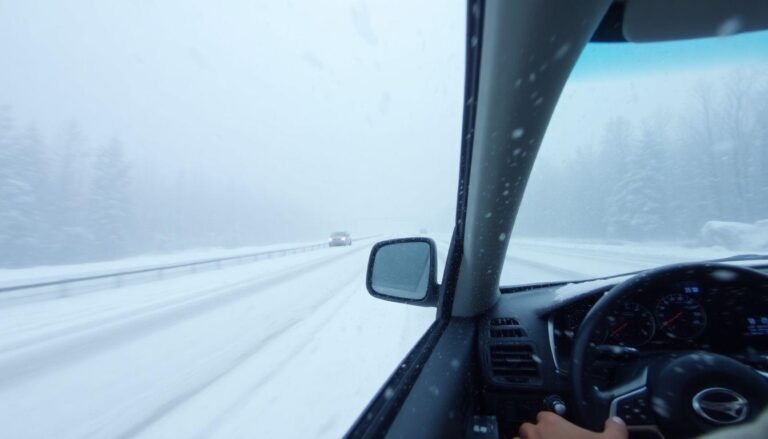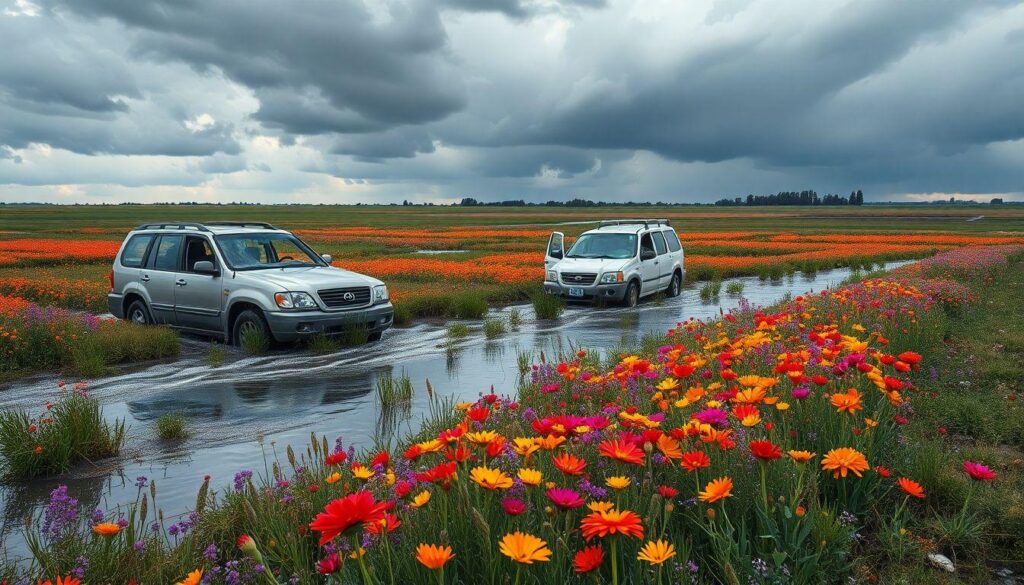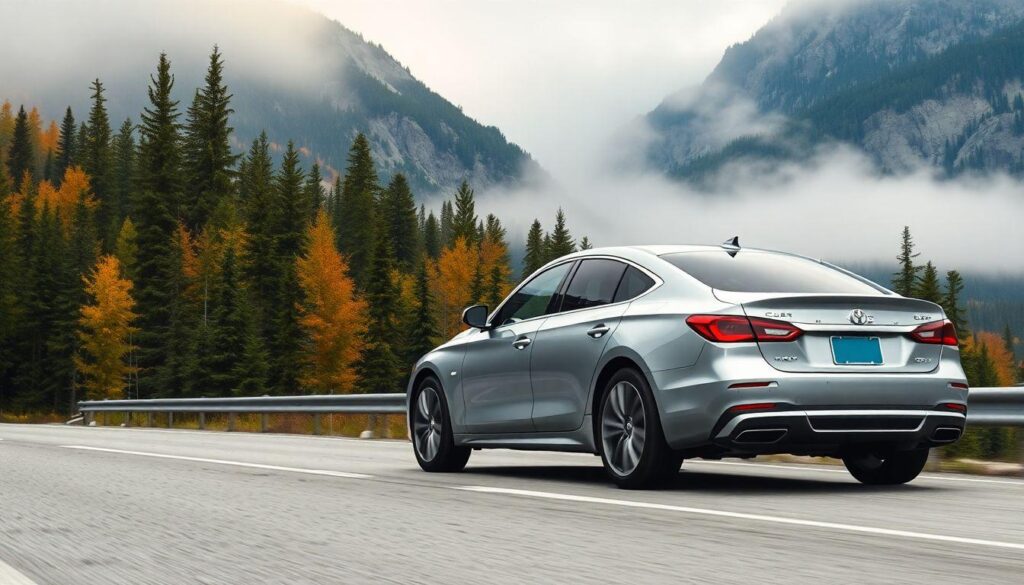Picture this: you’re driving through a sudden snowstorm in Ontario, visibility drops to nearly zero, and your car gently vibrates the steering wheel while automatically adjusting your speed. That’s not science fiction anymore—that’s 2025 Canadian vehicle safety tech working behind the scenes to keep you safe. This year marks a pivotal moment for automotive safety innovation, especially here in Canada where our unique driving conditions demand smarter, more adaptive solutions.
The landscape of automotive safety has shifted dramatically, and Canadian drivers are experiencing technologies that seemed impossible just a few years ago. From AI-powered collision avoidance to systems that actually learn your driving patterns, the vehicles rolling off lots this year are fundamentally different beasts than what we drove even in 2023.
Weather-Adaptive Safety Systems That Actually Get Canadian Winters
Let’s be honest—most vehicle safety tech has been designed with California highways in mind, not our brutal Canadian winters. But 2025 changes that narrative completely. The latest weather-adaptive safety systems use real-time atmospheric data combined with road surface sensors to adjust everything from braking sensitivity to lane-keeping assistance.
Take Toyota’s new Cold Weather Intelligence system, for instance. It doesn’t just detect ice; it predicts where ice is likely to form based on temperature gradients, humidity levels, and even the time of day. When you’re driving through that tricky stretch of Highway 401 at dawn, your car knows that bridge ahead is probably slippery before you do.
These systems go beyond simple traction control. They’re constantly communicating with local weather stations and even other vehicles on the road. If a car three kilometers ahead hits a patch of black ice, your vehicle gets the memo and starts prepping your anti-lock brakes accordingly.
Smart Tire Pressure and Grip Monitoring
Here’s something that’ll make you rethink those monthly tire checks. New vehicles now come equipped with individual tire sensors that don’t just monitor pressure—they analyze grip patterns, temperature variations, and even tread wear in real-time.
When you’re heading into cottage country and the temperature drops fifteen degrees, your dashboard doesn’t just tell you to check your tires. Instead, it automatically adjusts your vehicle’s stability systems to compensate for the reduced grip you’re about to experience.
AI-Powered Collision Avoidance: Your Digital Co-Pilot
The collision avoidance systems hitting Canadian roads this year aren’t just reactive—they’re predictive. Using machine learning algorithms trained on millions of driving scenarios, these systems can anticipate potential accidents up to eight seconds before they might occur.
What makes this particularly exciting for Canadian drivers is how these systems handle our unique traffic patterns. They’ve been specifically trained on scenarios like moose crossings in Northern Ontario, sudden fog banks along the Maritimes coastline, and the chaotic merge patterns around Toronto’s DVP during rush hour.
Pedestrian and Cyclist Detection That Works in All Seasons
Anyone who’s driven through downtown Vancouver during a winter downpour knows how challenging it can be to spot pedestrians and cyclists. The new detection systems use a combination of thermal imaging, radar, and advanced cameras to identify vulnerable road users even when they’re bundled up in winter gear or partially obscured by weather conditions.
These systems have been tested extensively in Canadian cities, learning to distinguish between a person waiting at a bus stop and someone about to step into traffic. They can even detect the subtle body language cues that indicate someone’s about to cross the street—pretty impressive when you consider they’re doing this through layers of winter clothing and often poor visibility.
Advanced Driver Monitoring: Keeping You Alert on Long Canadian Drives
Canada’s vast distances mean long drives are part of life here. Whether you’re heading from Calgary to Vancouver or making the trek from Montreal to Halifax, driver fatigue becomes a real safety concern. The 2025 model year introduces advanced driver monitoring systems that go way beyond checking if your eyes are open.
These systems use infrared cameras to monitor everything from your blink rate to subtle changes in how you grip the steering wheel. They can detect microsleep episodes—those dangerous moments when you nod off for just a few seconds—and intervene before you drift out of your lane.
Biometric Integration and Health Monitoring
Some of the more advanced systems can even monitor your heart rate and stress levels through sensors in the steering wheel and seat. If you’re driving through a particularly challenging stretch of the Trans-Canada Highway and your stress indicators spike, the system might suggest taking a break or even automatically contact emergency services if it detects signs of a medical emergency.
The privacy implications are still being worked out, but the potential for these systems to prevent accidents caused by medical events is significant. Imagine a system that detects the early signs of a heart attack and safely brings your vehicle to a stop while automatically calling for help.
Vehicle-to-Everything Communication: The Connected Safety Network
Perhaps the most revolutionary advancement in 2025 is the widespread implementation of Vehicle-to-Everything (V2X) communication. This technology allows your car to communicate not just with other vehicles, but with traffic infrastructure, emergency services, and even pedestrians carrying compatible devices.
Picture driving through downtown Toronto and receiving an alert that an ambulance is approaching from behind, complete with the optimal route to safely move out of the way. Or getting a heads-up that the traffic light ahead is about to change, allowing your car to adjust speed for a smoother, more efficient stop.
This network effect means that safety information spreads through traffic like a digital nervous system. When one vehicle detects a hazard—whether it’s a pothole, debris, or an accident—that information immediately becomes available to every other connected vehicle in the area.
Emergency Response Integration
The integration with emergency services represents a quantum leap in accident response times. Modern vehicles can automatically provide first responders with detailed information about a crash, including the number of occupants, the severity of impact, and even medical information if drivers opt into those services.
In rural areas where cell coverage might be spotty, these systems can relay emergency information through other connected vehicles, creating a mesh network that ensures help can be summoned even in remote locations.
Looking Ahead: What This Means for Canadian Drivers
The safety technologies rolling out in 2025 represent more than just incremental improvements—they’re fundamentally changing what it means to drive in Canada. These systems are designed with our unique challenges in mind, from harsh weather conditions to vast distances between populated areas.
For families, these technologies offer unprecedented peace of mind. Parents can feel more confident about teenage drivers navigating challenging conditions, knowing that advanced safety systems are providing an extra layer of protection. For commercial drivers covering long distances, fatigue monitoring and collision avoidance systems could significantly reduce workplace injuries and fatalities.
The transition period will require some adjustment. Learning to trust these systems, understanding their limitations, and knowing when to override them will be crucial skills for Canadian drivers. But as these technologies become more sophisticated and widespread, they promise to make our roads significantly safer for everyone.
As we embrace these innovations, it’s clear that 2025 Canadian vehicle safety tech isn’t just about preventing accidents—it’s about creating a more connected, intelligent transportation ecosystem that adapts to our unique needs and challenges. The future of driving in Canada is looking remarkably bright, even through the darkest winter storms.
If you found these insights helpful, feel free to share this article with your friends and followers who might be considering a vehicle upgrade this year!







